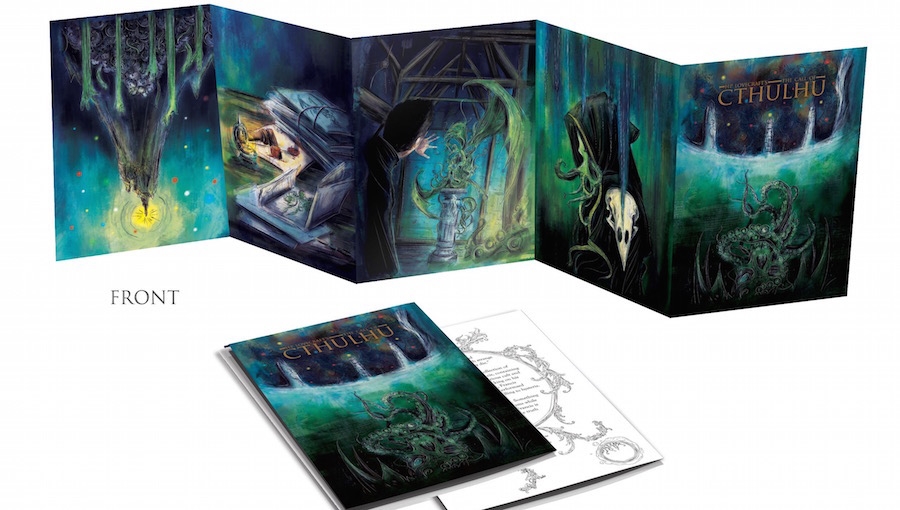“A mountain walked or stumbled. God! What wonder that across the earth a great architect went mad… The Thing of the idols, the green, sticky spawn of the stars, had awaked to claim his own. The stars were right again… After vigintillions of years great Cthulhu was loose again, and ravening for delight.”
Through most of the month of March in the year of 1925, the artisans and poets of the world where struck in a feverish delirium of dreams and creativity. The Great Old One Cthulhu had reached out from his sunken city of R’lyeh to his followers, and the artisans and poets of the world sought as best as possible to depict that which cannot be depicted.
If Great Old One Cthulhu could me memorialized in bas-reliefs and statues, why not in an accordion picture book format, as well?
That’s the goal of artisan Lyndon White: to retell H. P. Lovecraft’s most renown story, “The Call of Cthulhu,” in a concertina book format. The concertina (a.k.a. accordion) book is simply that: a book folded in such a way that it resembles an accordion (or a rather large Dungeon Master’s screen) between its covers, with double-sided pages which lend heavily to showcasing artwork. “The Call of Cthulhu” is White’s third foray into the medium, after having realized both Dante’s Inferno and Bram Stoker’s Dracula as concertinas, as well.
White’s approach to Cthulhu is textless, with emphasis instead on striking artwork. With only eight pages (and a cover) to play with, the majority of Lovecraft’s short story is excised from White’s version who instead focuses on imagery derived from the third and final part of the story, “The Madness from the Sea.” This part of the story concerns the fate of the Alert, a ship that accidentally stumbles upon the great city of R’lyeh, partially emerged from the depths of the Pacific. The crew inadvertently wakes Cthulhu, and it is only by steering the Alert into his head that Cthulhu is temporarily thwarted.
“The Madness from the Sea” looks to be comprised of the pages “Cult of Stars” (which seems to depict imagery from R’lyeh), “Door of Stars” (which can be interpreted as the door the sailors open that accidentally releases Cthulhu), “Wrath of the Old One,” (which specifically shows Cthulhu in pursuit of the Alert), and finally “Idol in the Cabin” which shows Johansen brooding over the Cthulhu idol in the Alert after he left R’lyeh. The other pages in the concertina are more abstract, mostly drawing inspiration from Cthulhu rather than adopting it directly. For instance, the page”‘The Lighthouse” looks to be re-appropriating Lovecraft’s other story, “The White Ship” into “The Call of Cthulhu.” The cover of the book also looks to be merging Dreamlands imagery with Cthulhu Mythos imagery.
Dark blues, dark greens, and black are the primary colors used in the concertina, with nearly all of the pages showing Cthulhu’s iconic tentacles slithering about. The color scheme ensures that each page flows seamlessly into each other. White’s artwork is superb, with the best page easily being “Cult of Stars.” It’s ironically one of the few pages that lacks Cthulhu imagery, but instead portrays Lovecraft’s vision of pure cosmic dread at its most succinct: the stars in the distance with the stone stairs flanked by black robed figures. The stairs are of particular note in that them seem to actually capture the non-Euclidean nature of R’lyeh; the stairs lead both upward and downward at the same time. “Cult of Stars” is simply the most effective, evocative, and original piece in the book.
The other pages in “The Call of Cthulhu” are expertly realized, though White does play it safe with his depiction of the Great Old One. White’s Cthulhu is extremely detailed and shown in all his mammoth glory on the page “Wrath of the Old One,” yet this version of Cthulhu does not deviate too heavily from most renditions of the creature. Within the story, the is one descriptor that Lovecraft has used to describe Cthulhu that most artists fail to incorporate into their work: “bloated corpulence.” With White taking Lovecraft’s story to a unique and original medium (the accordion book), it would’ve been a perfect opportunity to depict Lovecraft’s iconic monster in a new way. After all, Cthulhu himself is almost indescribable and incomprehensible, and this gives artists a free pass to really approach illustrating him in unique ways. Regardless, White’s Cthulhu is still a sight to behold, and the build up to his reveal in the book is subtle and suspenseful.
As a whole, White’s experiment with transposing Lovecraft’s story to an accordion book is successful. It’s different and the brilliant artwork really conveys an eldritch and cosmic feeling. The art-only approach also allows the book to be paired with other mediums; it would go well with some dark ambient music or even having an audio book version of “The Call of Cthulhu” playing. In this regard, the accordion book is both literally and figuratively flexible in how it can be enjoyed.
Creative Team: Lyndon White (art and adapted by), H. P. Lovecraft (original story)
Publisher: Lyndon White
Click here to purchase.
Nicholas Diak is a pop culture scholar of industrial and synthwave music, Italian genre films, peplum films, and H. P. Lovecraft studies. He contributes essays to various anthologies, journals, and pop culture websites. He is the editor of the anthology, The New Peplum: Essays on Sword and Sandal Films and Television Programs Since the 1990s. He can be found at nickdiak.com.

